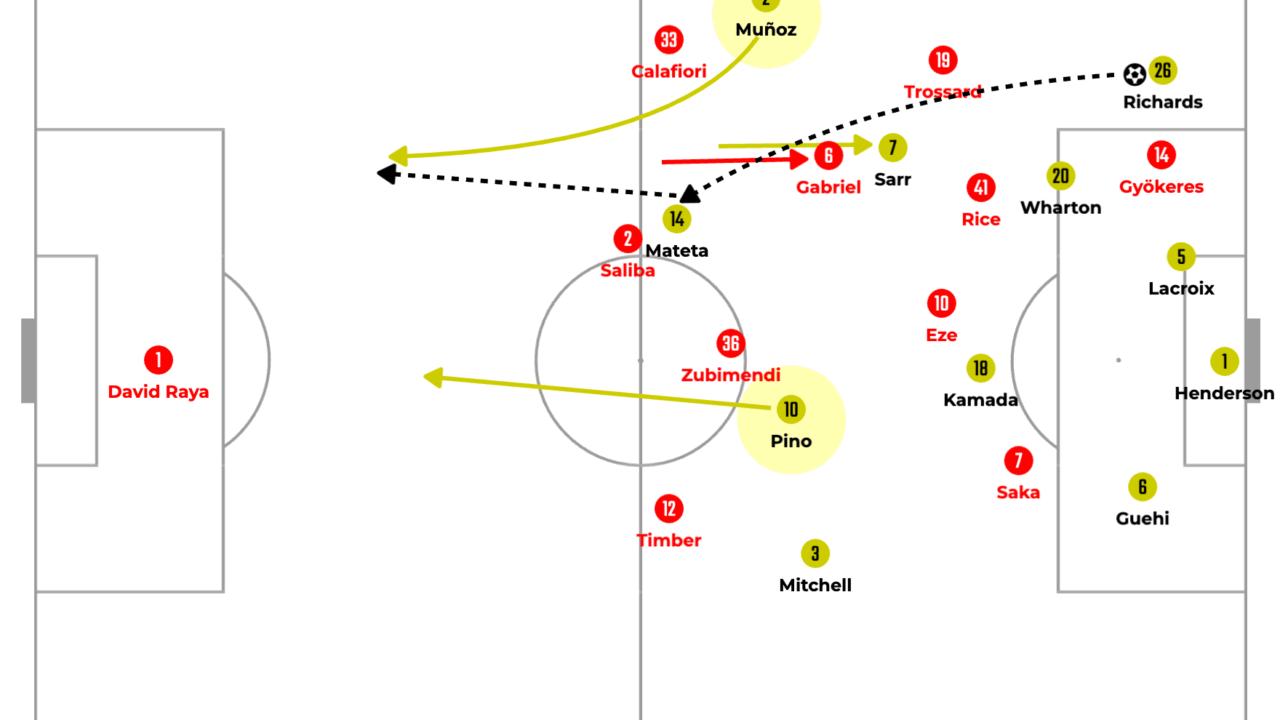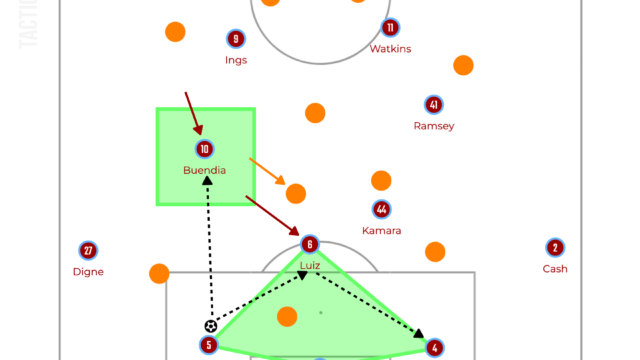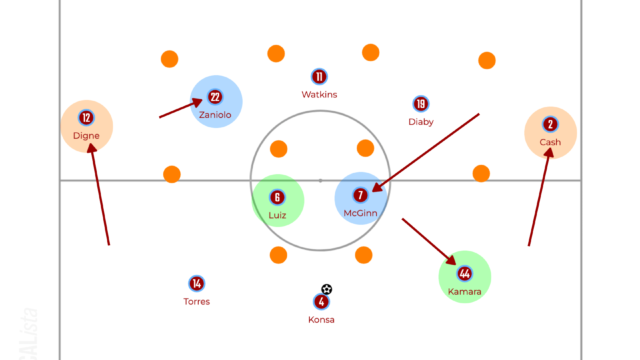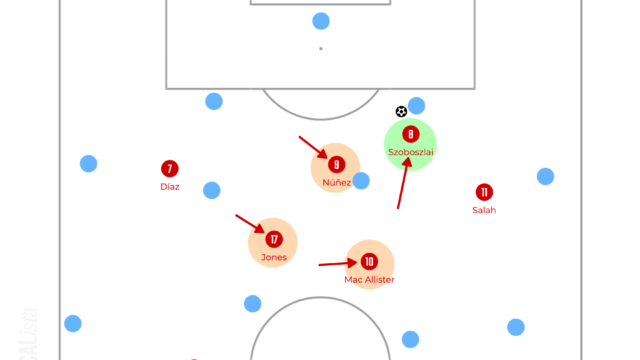In this article, the tactics of Crystal Palace under Oliver Glasner are going to be analysed.
They have achieved the 19-game unbeaten run since April in 2025 across the seasons, which is a club record and ended by the defeat against Everton away from home, and the analysis of them will reveal how they became the FA cup champions last season and one of the most exciting teams in the league.
In Possession
Build up
When playing out from the back, they often start to play short to draw the opposition pressing and try to exploit the space up front. The back three position themselves deeper and they play a few passes to let the opposition press high.
The example below shows how they tried to beat Arsenal’s pressing in the 23rd minute of the game.

Arsenal pressed really high and as the ball was played to Richards, Gyökeres tried to lock them in and other players shifted to man-to-man approach.
However, this is what Glasner wanted.
At the same time, Sarr dropped deep to drag Gabriel out of his position and expose Saliba at the back, and Richards played over Sarr to target Mateta, who can win most aerial duels or at least make it difficult for the opposition centre back to clear the ball well.
Additionally, the right wingback Muñoz and the left attacking midfielder Pino made runs in behind to get the ball flicked by Mateta. This time, Mateta could hold it up and played a through ball to Muñoz, who could take a shot but was slightly offside.
Mateta can not only be a target player when playing in the air, but also drop to receive the ball at the right moment and switch it to the opposite wingback.

This can help the team to progress into the opposition half with a more secured way. Playing in the air can be an option, but it becomes more of a gamble. Thus, having this route makes the team more stable against the opposition pressing.
The other attackers, such as Pino or Sarr can also be options in between the lines.

Like the illustration above, they can receive the ball and lay it off to either of the defensive midfielders, Kamada or Wharton who can carry it forward to increase the tempo of the attack. As Palace want to progress forward quickly, their ability to carry the ball strongly is extremely important.
So, when they play out from the back, their objective is not stabilising the possession, but playing through or over the opponents to exploit the space up front. Therefore, as soon as they can break the opposition midfield line, Mateta or/and Sarr make a run in behind to get the ball there.

This is the example of Mateta making a run in behind and creating a 1v1 situation against Alisson who made a good save here. In this kind of situation, Mateta is one of the best centre forwards in the league. His pace and physicality play a huge role when Palace play out from the back.
Overall, Palace want to exploit the space up front quickly, so they start to play short to drag the opponents out. Then, they play long to Mateta or find one of three attackers to speed it up. Especially Mateta’s ability of winning aerial duels or finding space to drop into is the biggest strength, but Guehi, Lacroix and Richards are good ball playing centre backs, who don’t suffer from the opposition high pressing and calmly find the attackers up front.
In the midfield, they are quite static and keep their system of the 3-2-5. But, Glasner effectively makes the most of the system.
Thanks to the wingbacks keeping the width, Palace can use the pitch as wide as possible and they try to switch the ball to the opposite wingback to escape from the opposition pressure and progress into the midfield.

This is the example against Arsenal, which shows how they used the width well. From Mitchell to Muñoz, they switched the ball from the left to right and this was enough for them to get into the opposition final third. Usually, when the defending team tries to lock the attacking team in the ball side, they squeeze to the one side while leaving the opposite side open. Therefore, switching the ball to the opposite side is also an effective option to beat the pressing and progress.
Final Third Attacking
When they arrive in the attacking third, their wingbacks turn into the wingers. To explain this, the illustration below is a great example.

Liverpool let Lacroix have the ball, so he could play in behind comfortably. Mitchell was targeted and he managed to get it before it went out of the pitch and cut it back. And, it was Muñoz who received the cutback and took a shot.
This is their strength and Muñoz has been involved in the goals a lot in recent games.
The first example is his goal against Everton.

As it was explained in the previous chapter, Palace’s build up aims to find an attacker in between the lines and play fast breaks, and it worked here. Pino received the ball in between the lines and gave it to Sarr and Palace created a 3v2 overload against Keane and Mykolenko. Sarr carried it to the edge of the box and played it to Muñoz who arrived at the edge of the six-yard box to find the back of the net.
In their next game against Bournemouth, he got involved in the first two goals to equalise.

This is the first goal that Muñoz provided an assist. Lacroix played to Mateta after securing the ball cleared by the opposition defender. Then, he passed it to Sarr and again, Muñoz received the through ball from Sarr to deliver the low and fast cross to Mateta.
The illustration below shows the movements when they scored the second goal.

This time, he was found by Kamada who delivered the in-swinging cross to the edge of the six-yard box and played it back with his first touch, which was a little bit deflected by the opposition goalkeeper and tapped in by Mateta.
These examples show how important it is for the wingbacks to be extra attackers. Muñoz and Mitchell are willing to step high and play like wingers. Thanks to them, it becomes more difficult for the team especially with a back four to defend Palace’s overload.
Another way to make the most of the wingbacks is stretching the opposition back line to penetrate the inside. The illustration below is a pattern which can be seen many times.

As soon as Muñoz received the ball, the opposition fullback tried to close him down to prevent from delivering crosses. However, this opened the gap between the fullback and centre back, where Sarr made a run and received the ball from Muñoz. So, even if they manage to defend Muñoz, it can give a more dangerous option for Palace.
Overall, in the attacking third, the wingbacks are vital for Glasner’s team. It creates overloads against the opposition back line and the aggressiveness of them generates a lot of chances. Specifically, Muñoz has got involved in the goals in recent games and now is a heart of Palace’s attacking structure.
Out of Possession
High Pressing
Pressing high is not their priority, so it is rare for them to apply pressure on the opposition goalkeeper. They sometimes set the line high and press when the opposition centre backs keep possession, and when doing this, the aim is to force them to play outside and lock them in.

Like the illustration above, Mateta forces the opposition centre back on the ball to play outside and the attacking midfielder presses on the opposition fullback. Then, by forcing him to play long and securing the second ball, they can regain possession in the opposition half.
However, they are not as enthusiastic about pressing high as others, so they often easily let the opponents progress into the midfield.

Against Arsenal, Pino was pinned by Timber even when Palace tried to press and he couldn’t stay as high as Sarr, so Saliba could gain the space to step in.
Middle Third & Final Third Defending
As they are not willing to step up to press high, they spend more time setting the defensive block and allowing the opposition to progress into the midfield. From the middle third, Palace organise a compact defensive block which has caused problems for many opponents.

Not only keeping their shape compact, but also Guehi and Richards often leave the back line to mark the opponents in between the lines. This makes it more and more difficult for them to find spare players in between the lines. Then, while the opponents struggle to find ways to play through, Palace win the ball back and threaten them by counterattacks.
However, in recent games, the opponents found a way to exploit the space behind the wide centre backs.

The illustration above replicates the third goal for Bournemouth. As Truffert carried the ball forward, the right centre back Richards stepped up to stop him, leaving the space in behind him. The space was exploited by Tavernier who made a run from a deep area and they could find him through Gannon-Doak. Then, Tavernier delivered a low cross and Christie found the back of the net at the end of the second half.
Another one can be found in the game against Everton.

This time, two attackers made runs in behind Richards and Lacroix committed a foul inside the box, providing the penalty kick for Everton. Initially, Lacroix marked Beto, which made it difficult for him to deal with someone else on his blind side in this underloaded situation.
So far, the negative side of their final third defending was discussed, but mostly their defensive organisation is great and not only solid but also a threat for the opposition.
They don’t just park the bus, but as soon as the opposition player plays back, the attackers chase it and push the lines up.

These pressing can eventually result in the opposition turnover, or at least they can come back to the midfield. Therefore, the opposition team needs to progress again, so it can reduce the probability of “something happens”. They don’t just defend the goal, but keep applying pressure on the ball.
If they can win the ball back, their counterattacks are immediate threats.

After winning the ball back, either of the attacking midfielders often receives the ball in the pocket of space and then plays in behind to meet Mateta or carries it forward. Their compact defensive block makes it easier for them to find a teammate after winning the ball back, so they are able to play more secured counterattacks rather than kicking the ball away to hope for Mateta, even though this can be a proper counterattack with his ability.



